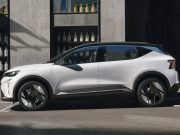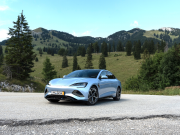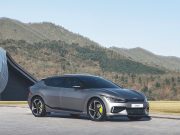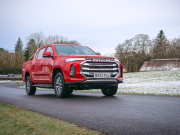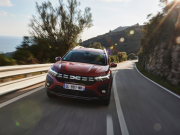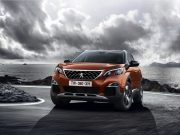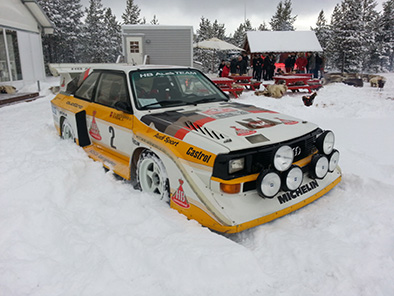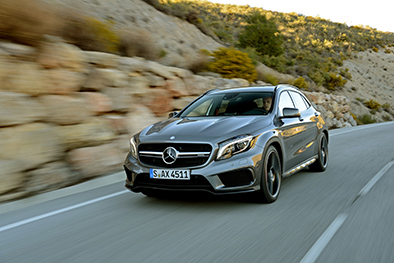 E-commerce has kick-started exponential growth in freight transport, traffic restrictions in city centres are tightening, and delivery professionals, tradespeople and retailers are realising that their needs will soon outgrow conventional vans. Renault Group is using the new FlexEVan platform that Renault developed with its partners in Flexis to build its vision of the next dream utility vehicle – 65 years after the Estafette revolutionised the van universe. The specs are based on professionals’ requirements and feedback, and the two main goals are keeping drivers and goods safe, and keeping loading and unloading swift.
E-commerce has kick-started exponential growth in freight transport, traffic restrictions in city centres are tightening, and delivery professionals, tradespeople and retailers are realising that their needs will soon outgrow conventional vans. Renault Group is using the new FlexEVan platform that Renault developed with its partners in Flexis to build its vision of the next dream utility vehicle – 65 years after the Estafette revolutionised the van universe. The specs are based on professionals’ requirements and feedback, and the two main goals are keeping drivers and goods safe, and keeping loading and unloading swift.
“We are very excited about helping to bring to life the vision that Renault Group and its partners Volvo Group and CMA CGM Group have come up with to revolutionise urban logistics , to make operations more sustainable, safer, city- friendlier, driver – friendlier and neighbour- friendlier. Estafette Concept is the first example of what electric utility vehicles will look like tomorrow: purpose- engineered to drive in cities, compact, connect ed and built for fully sustainable delivery services. ”
Philippe Divry, CEO, Flexis SAS
The Estafette’s pioneering legacy Estafette Concept has much more in common with Renault’s emblematic 1959 van than the jovial round headlamps. They are both radically innovative and practical. The original Estafette was the very first Renault brand vehicle to fit the entire powertrain – engine and transmission – at the front to free up all the space behind for loading. The new Estafette 4.0 is the first to feature the FlexEVan electric platform, which is poised to upend the utility vehicle landscape. They were both designed to make life easier for delivery drivers, tradespeople and retailers, and are both remarkably compact – ample inside yet easy to park. They both have two sliding doors for unparalleled convenience and safety. And they were both designed for and with professionals. In 1959, Renault launched its Estafette with a France-wide delivery tournament. Estafette Concept will become a production van in two years’ time, so watch this space!
Estafette Concept’s footprint (4.87 x 1.92 metres) is in the same league as Kangoo L2’s (4.91 x 1.86 metres). They both fit in a standard parking spot (less than 5 metres long), while being more agile, with a turning circle between kerbs similar to that of a Clio (just over 10 metres). But Estafette Concept is considerably higher (2.59 metres compared with 1.85), so its silhouette is distinctly vertical. The driver, as a result, can effortlessly move back and forth between the cockpit and cargo area. The pocket sliding side doors open with one swift motion, so the driver doesn’t have to constantly pull them outwards and backwards then back again. They save a substantial amount of time and are much easier on the driver’s wrist when they make dozens of stops a day.
The shutter at the rear rolls around itself, opening up the van’s full height. And it doesn’t have a tailgate or swing-out doors, so you don’t need any clearance space behind (even though a large step unfolds automatically every time you open the shutter). The van can for example reverse all the way up to a dock for easy loading, for a total load capacity close to that of a Trafic L1H2 (7.1cu. metres). The shutter is used exclusively for loading and the sliding door alongside the pavement is used exclusively for unloading, to keep the driver completely safe.
The sleek outline – the only prominent feature is the ripple underlining the grille bar – gives Estafette Concept a gentle feel that conceals technology at the height of perfection. Think Smeg fridge meets plush toy. Cities would look so much more dazzling from above if every delivery van had a pop top! Estafette Concept joins in the fun with a Tropical Yellow roof over a Helium Grey cab, but the two-tone body has another advantage, too: it softens the van’s towering height.
A commanding grille bar protrudes from the otherwise soft contours on Estafette Concept’s prow, beneath the windscreen base, to draw the eye to the van’s brand. The backlit Renault Nouvel’R logo is distinctly reflected in the new signature LED pattern forming large vertical fragments of the logo at the ends of the bar. The base of the prow has two large headlamps with a 3D look to magnify the techy effect. They are linked by a black strip providing the background for the Renault monogram and housing a built-in camera. The monogram also appears on the sills to make the brand even more prominent.
The cockpit area is all zesty yellow and has a single seat for the driver (the foldaway seat next to it is exclusively for training). The seat is on a platform, so the driver is in a comfortable, secure position. All they have to do is swivel the seat to stand up without any extra strain on their legs or torso. And anyone up to 1.90 metres tall can stand up perfectly straight inside. The platform under the seat has 7 drawers (3 on the door side, 4 on the other side). Estafette Concept’s dashboard is packed with technology and has no visor in the steering wheel area. It is divided into a 7-inch screen displaying dashboard information and a 12-inch screen towards the middle, facing the driver. The base of the screen, the surface at the centre of the steering wheel and the area towards the door include a series of widgets providing one-tap access to the driver’s favourite features. The multimedia system’s open technology can run a variety of software applications developed specifically for the trades using the vehicle.
Two 10-inch vertical screens at the end of the dashboard display the rear views from the outside cameras. Towards the centre, you can’t miss the cylindrical shape on the dashboard. This area is a solid counterpoint to the airier, techy feel in the screens to the side. The grooving on the cylinder and under the dashboard is built to hold a choice of open or closed storage modules. A second, matching cylinder provides extra storage space beneath the windscreen, supplanting the overhead bin. Patterned small squares add a 3D feel to the flat surfaces and the screen wallpaper.
A sliding door divides the cockpit from the cargo area. It closes automatically when the driver returns to the cockpit or exits the vehicle – so the goods in the back are safe at all times. The cargo area has four foldaway shelves where the driver can arrange goods in a clear and logical manner. Every detail of the exterior and interior design is streamlined for smooth and extremely safe operation. During rounds, for instance, the driver will never need to open the rear shutter or step out onto the road. This keeps them safe – and their goods safe (the cargo is never accessible or visible from outside the van).
The Estafette Concept is Renault Group’s first vehicle built around an SDV (Software-Defined Vehicle) electronic architecture. It is opening the door to the next generation of electric utility vehicles, which will be intelligent, scalable and modular. This SDV architecture was developed by Ampere, Renault Group’s pure-player specialist in intelligent electric vehicles, is directly connected to the cloud, and plays an essential role in increasing the vehicle’s operational and cost efficiency. It links customers to new services, updates the vehicle throughout its life cycle, learns about the user’s habits and contributes to reducing cost in use by about 30%. SDV technology is especially helpful in utility vehicles because it provides a variety of new possibilities for personalisation – which are in very high demand among professionals. It also enables customers to add high-efficiency power outlets, which are essential for a number of conversions (to add a refrigerated compartment or special lighting in a work area, for example).
And you won’t need any additional fuses: the built-in panel contains three high-intensity outlets, and is the only interface you need to securely power all the new electrical appliances associated with the conversion. The van’s SDV technology also adapts to the ecosystems in all the management infrastructures currently used by fleets. And, depending on the type of conversion, the dashboard can seamlessly display any associated information (the temperature in the refrigerate compartment, for instance). SDV architecture essentially turns a vehicle’s electric and electronic wiring into a smart system, including high-performance computers and new connected devices, which in turn instantly supply the van’s computers with massive amounts of data.
The experience in an SDV is like the one at home when we upgraded from a dial-up modem to ADSL then fibre optics: the amount of data we can download is considerably higher. An SDV can download and integrate substantial updates, upgrades and new content throughout its life cycle. To scale up, the software needs to be separate from the hardware, and you need the software that will last the longest. And, again, the system is a lot like a home connection: you need to be able to increase the platform’s memory and performance. Open software also helps to improve electricity management, so it is making electric vehicles ever more efficient and smarter. With updates, SDVs can also adapt to the customer’s preferences and get better throughout their life. And the automotive sector is constantly enhancing safety (for drivers, passengers and people around the vehicle) as much as security (to protect onboard systems from malware).













